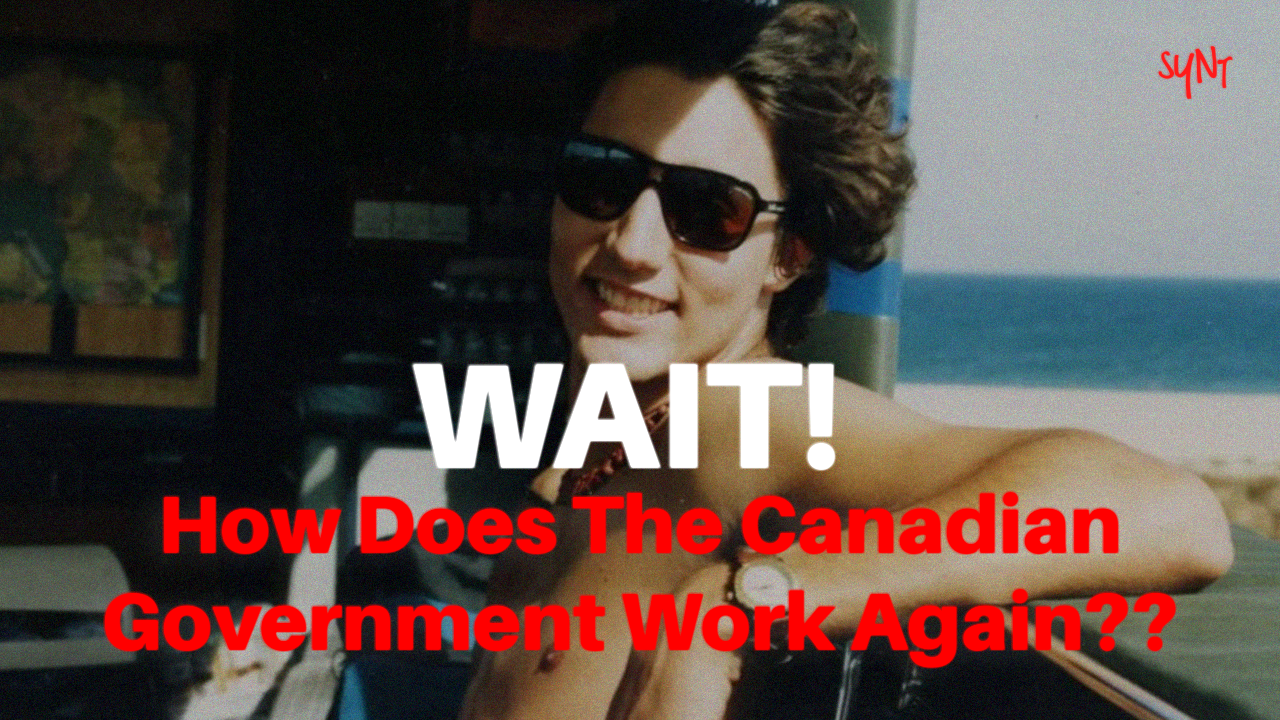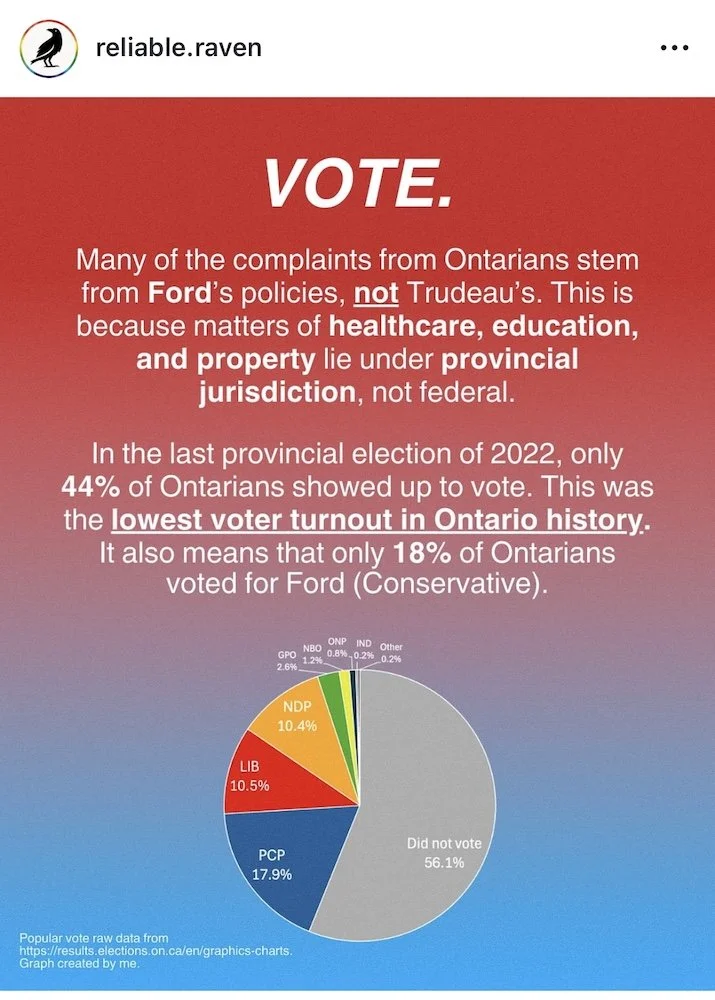Wait - How Does The Canadian Government Work Again??
Want to support a small Canadian business? Buy one of our Made in Canada Rhinestone Tote Bags Today!
Our TL;DR of the Canadian Government
I’m not proud to admit that up until writing this article, I barely understood how our government works. I first learned about it in grade 5, then again in grade 9, and then… never thought about it again. Why? Because it seemed BO-RING. But now that my frontal lobe is fully developed and the world’s a political and economic dumpster fire, I figured it’s time for a refresher. So here is everything you need to know about the Canadian government—translated for Gen-Z brainrot (sans skibbidy).
Who Is In Charge Of The Canadian Government?
Federal (The Prime Minister)
Handles the whole country. Think immigration, military, money, trade, and big-picture laws.
Provincial/Territorial (Premiers)
Runs the province/territory. Think healthcare, education, highways, and natural resources.
Municipal (Mayors)
Your city/town. Deals with transit, garbage, parks, police, and local bylaws.
Bonus: Regional (The Regional Chair)
A federation of smaller municipalities. They deal with water, emergency services, and waste management (e.g. the Regional Municipality of Peel that includes the cities of Mississauga, Brampton and Caledon.)
A visual example of the Durham Region showing the division of responsibilities for levels of Canadian government (source)
So…Who’s Actually In Charge?
Technically, Canada’s head of state is King Charles III, but he’s mostly for show.
The Governor General (currently certified baddie, Mary Simon) represents him and gives laws “Royal Assent”, which is basically a stamp of approval that magically makes the law real.
The Prime Minister (PM) is the real boss.
Elections
(How the Canadian Government Gets Picked)
Every 4-ish years, we vote for people to represent us.
Federal elections
We vote for Members of Parliament (MPs) → Party with the most MPs = their leader becomes Prime Minister.
Provincial elections
We vote for Members of the Provincial Parliament (MPPs, MLAs, MNAs, MHAs, so many acronyms for the same job) → Party with the most votes = their leader becomes Premier.
Municipal elections
We vote for mayors & city councillors. No political parties, just vibes.
The Main Federal Pop Girlies
(The Main Canadian Parties)
Liberal Party (Red)
Center-left, valuing social programs, climate action, and government investment in infrastructure and services.
Conservative Party (Blue)
Right-leaning, prefers tax cuts, economic growth through privatization, and less government involvement in social and economic matters.
New Democratic Party/NDP (Orange)
Further left, pro-worker, expanding public programs like healthcare and pharmacare, climate focus, progressive taxation (e.g., taxing the wealthy and corporations).
Green Party (Green, obviously)
Centre-left, heavy environmental focus, sustainable policies, social justice and promoting a green economy. Often overlaps with NDP policies but with a greater environmental focus.
Bloc Québécois (Blue, but only in Québec)
Québec nationalism, French language rights—while it participates in federal politics, it is not interested in forming government outside of its Québec-focused agenda.
Map showing the 2021 Canadian Election results by province and territory. (source)
How Federal Laws Are Made
(The Slow, Painful Process)
Someone (usually the gov) proposes a law (a bill).
It gets debated in the House of Commons in Ottawa (MPs argue, think: “Mr. Speaker!”)
If it passes, it goes to the Senate for more debates.
If it survives, the Governor General (Canada’s royal rep) gives the final thumbs-up.
Boom—it's law.
Real Example: The Ban on Single-Use Plastics (Because We Like Turtles)
In 2022, Canada passed a law banning single-use plastics like straws, grocery bags, and takeout cutlery to cut down on pollution.
The government proposed it → Parliament debated it → It got approved and phased in over time.
Now, when you get a soggy paper straw at McDonald's, you can blame (or thank) this law.
Laws take time, but when they go through, they can change everyday life—sometimes in ways you immediately notice.
Who Is Running The Canadian Government Right Now?
Federal (Whole Country)
Prime Minister: Justin Trudeau (Liberal) – Been in power since 2015, currently fighting for his political life. He announced on January 6th, 2025, that he will resign and a new Liberal leader will be chosen by March 24th.
Opposition Leader: Pierre Poilievre (Conservative) – Wants Trudeau out and is focusing on economic and anti-tax takes.
Ontario (Our Provincial Gov)
Premier: Doug Ford (Progressive Conservative) – The guy in charge of Ontario since 2018. Think highways, buck-a-beer, and swallowing a bee.
Speaking of Dougie…
Doug Ford called a surprise early election (aka a "snap election") because of some economic drama—basically, Trump might slap tariffs on Canada, and Ford wants a fresh mandate before things get messy.
Who Is Running In the Ontario Election?
Doug Ford (Progressive Conservative – Blue)
The current Premier, running for a third term.
Likes building highways, cutting red tape, and lowering taxes.
Opponents say he’s not doing enough for healthcare & education.
Marit Stiles (NDP – Orange)
The official opposition, trying to take Ford down.
Big on workers’ rights, public healthcare, and housing affordability.
Trying to get people to see the NDP as the real alternative.
Bonnie Crombie (Liberal – Red)
Mayor-turned-Liberal leader, trying to rebuild the party after their flop era (they got wiped out in the last election).
Campaigning on healthcare, transit, and “reversing Ford’s failures”.
Some people think she’s too similar to Ford on some policies.
Mike Schreiner (Green – Green, duh)
The first Green MPP elected to the Ontario Legislature (go off king).
All about climate action, sustainable job creation, social equity, and better urban planning.
Under his leadership, the GPO has experienced substantial growth in voters.
Map showing the results of the 2022 Ontario provincial election.(source)
Why Does This Matter?
Economy & Jobs – Ontario could take a hit if Trump slaps tariffs on Canada.
Housing Crisis – Prices are insane, and everyone’s fighting over the best way to fix it.
Healthcare & Education – Wait times, underpaid workers, and underfunding are huge issues.
Climate & Environment – Greenbelt scandals, highway expansions, and sustainability policies are all on the table.
And Yes, your one vote matters
Source: @reliable.raven
It may feel like your one vote doesn’t matter that much, but when everyone thinks like that, this is what happens: 56% of voters didn’t participate in democracy last time. Politics matter and will directly affect your quality of life. I don’t care how boring or annoying you may think them to be — Just vote, just vote (eye roll).
What’s Next?
Expect lots of campaign ads, spicy debates, and politicians participating in TikTok trends. If you’re in Ontario, make sure you’re registered to vote for February 27th—this election is gonna be big.







